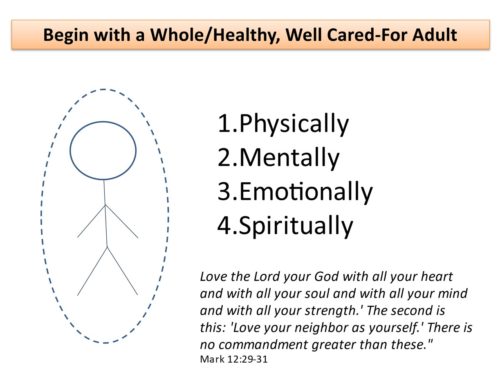The rational mind takes a few moments longer than the emotional mind to register and respond. So in an emotional situation, the heart moves first, not the head. So says Daniel Goleman, author of Emotional Intelligence. But there are also emotional responses that are somewhat slower, which fester or bubble up in our thoughts first. So our thoughts or cognition more or less determine which emotions will be rising next, usually based on past experiences. In other words, our thoughts precede our feelings.
The logic of the emotional mind is associative; it takes elements that symbolize a reality, or trigger a memory of it, and make it to be the same as that reality.” Our logical mind connects cause and effect. But our emotional mind takes its ‘beliefs or feelings’ to be completely true; perceptions that are reality.
When we are reminded of something,
it can become much more important than what it actually IS!
So, If my rational and emotional minds are both at work in seemingly contradictory ways, then how can I be self-controlled, not driven by my emotions and increase my EI?
Enhancing Emotional Intelligence
Invest your efforts in the following traits and characteristics:
Self-Awareness:
EI is the ability to recognize and understand emotions in yourself and others, and use that awareness to manage your behavior and influence your relationships. In other words, it’s a heightened sense of self-awareness. This is true in work relationships also; managers who are self-aware make better decisions, communicate more effectively, and relate well to others.
Be More Open:
To new things, perspectives, opinions, experiences. Be receptive to others.
Adam Grant in his book Give and Take says there is a “perspective gap.” When we are not currently going through a situation ourselves, it is hard to understand how we would feel in that situation even if we have experienced it previously. We forget quickly how important or strong the emotions were at that time. When we can focus our perspective on the feelings of others, rather than on their actions, it is easier to understand them.
Positive Attitude:
This is considered as a greater predictor of success than IQ according to Psychologist Carol Dweck. People with a growth mindset, or attitude, believe effort can help them improve. They outperform those with a fixed mindset, even when they have a lower IQ, because they embrace challenges, treating them as opportunities to learn something new
Know yourself!
See yourself fully; your good and not so good parts. What are my strong characteristics, and where do I need growth? What am I good at, and where do I need help?
Be Aware of and Understand Your Own Emotions:
Learn the difference between positive and negative emotions. Remember, all emotions are appropriate, but not all thinking or all behaviors are healthy. Both are legitimate, not good or bad, but the positive emotions are ones we want to feel, and see and feel from others. Negative emotions are not ones we want to stay in for very long, but understanding and expressing negative emotions makes us “fully human.”
Express Your Feelings:
Be able to name your emotions. Use an emotions or feelings chart to help give words to your feelings. Depth of understanding and meaning are communicated when emotions are shared. (see Feelings Chart below)
Be Empathetic and Compassionate:
Not critical and judgmental. Empathy is the action of understanding, being aware of, being sensitive to, and vicariously experiencing the feelings, thoughts, and experience of another person. Compassion is from Latin pati- to suffer- and cum- -to bear along. It is sympathetic consciousness of another’s distress, together with a desire to alleviate it.
Be Aware of Dysfunctional Thinking!
Remember, these often lead to quick emotional reactions whose behaviors may not be healthy or appropriate. Is what you are thinking true, based on facts that have been proved over time?
We do not have to be controlled by our reactions. We can become more intelligent and learn to better recognize and understand our emotions so that we use them for greater influence in all of our relationships, both at home and work.
Feelings Chart
By Michael Dawson, MA, LPC
Joy |
Sad/Guilt |
Angry |
Lonely |
Fear Anxious |
Powerful |
| Excited | Depressed | Frustrated | Isolated | Overwhelmed | Confident |
| Happy | Despairing | Enraged | Alone | Uptight | Discerning |
| Optimistic | Hopeless | Outraged | Shame | Afraid | Faithful |
| Energetic | Apathetic | Hurt | Guilt | Timid | Appreciated |
| Sensuous | Worthless | Resistant | Offended | Cautious | Valuable |
| Enthused | Guilty | Hostile | Confused | Pessimistic | Respected |
| Glad | Ashamed | Selfish | Rejected | Nervous | Worthwhile |
| Amused | Remorseful | Hateful | Helpless | Worried | Proud |
| Creative | Sleepy | Critical | Submissive | Concerned | Successful |
| Playful | Tired | Distant | Insecure | Apprehensive | Important |
| Hopeful | Bored | Sarcastic | Inadequate | Fearful | Aware |
| Fascinating | Isolated | Jealous | Embarrassed | Frightened | Influential |
| Stimulating | Inferior | Skeptical | Insignificant | Eager | Potent |
| Cheerful | Stupid | Mad | Discouraged | Restless | Vigorous |
| Daring | Miserable | Annoyed | Bewildered | Fretful | Dominant |
| Pleased | Gloomy | Irritated | Friendless | Uneasy | Commanding |
| Regretful | Judgmental | Unsafe | |||
| Disparaging | Vulnerable | ||||
| Derogatory | |||||
| Infuriated | |||||
| Furious | |||||
| Resentful | |||||
| Bitter | |||||
| Disgusted | |||||
Universal Emotions
- Anger/Rage
- Joy/Elation
- Sadness/Despair
- Fear/Anxiety
- Shame/Disgust
- Surprise/Curiosity







